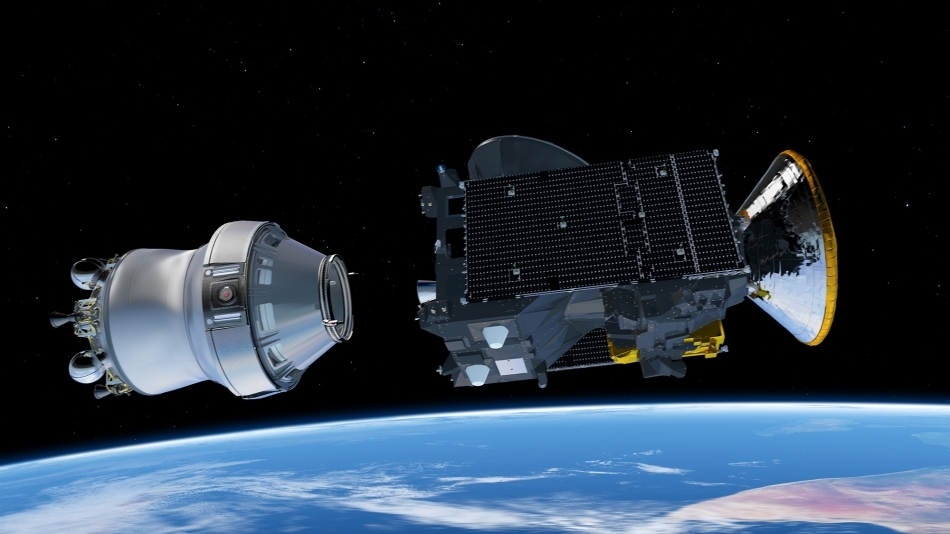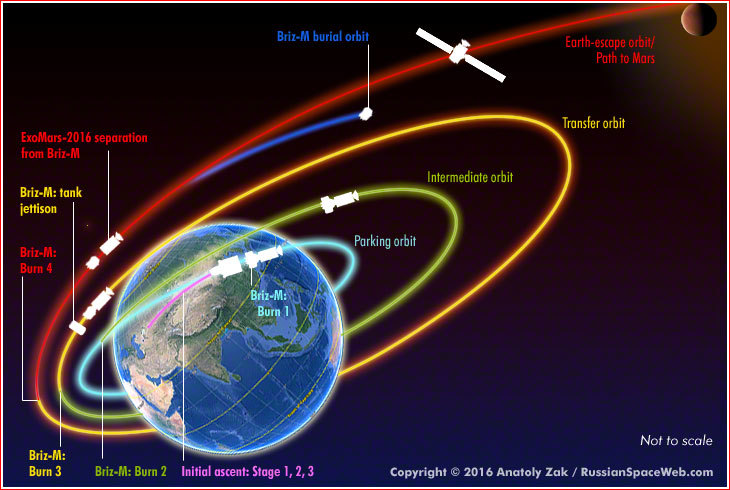Twelve hours of fear for ExoMars

This Monday will be very nervous. At 12:31 Moscow a launch of the Martian probe ExoMars is to take place. But breathing out with relief will be possible only after twelve hours. The probe will be displayed on a trajectory to Mars in four stages, and the first signal after separation from the upper stage should be received only at 00:29 MSK. And there really is cause for concern. The Proton launch vehicle last time launched an interplanetary probe in 1996, and Mars-96 did not fly farther than Earth’s orbit. The Briz-M overclocking unit will work longer than usual, according to a unique derivation sequence diagram, which is used for the first time. And, of course, it is impossible to forget our dramatic accidents of recent years. I offer you a small overview of the mission, a story about the terrible hours of launch and a list of resources on which news will appear.
Briefly about the devices
The project "ExoMars" consists of two stages. In 2016, the orbiter ExoMars Trace Gas Orbiter and the landing demonstrator Schiaparelli are launched. in 2018 (but rumors are already circulating about the shift for 2020) a rover will have to go to Mars. Initially, the project was considered as joint between NASA and ESA, but in 2013, due to budget constraints, NASA withdrew from cooperation, and Roskosmos became a full partner of the ESA. From the middle of the 2000s, the mission changed its appearance, the launch vehicles used, the number of rovers, the set of equipment, and, as a result, divided into two parts, which should go to Mars on the "Protons"
Orbital probe Trace Gas Orbiter

')
Trace Gas Orbiter will solve two main tasks - scientific and engineering. The scientific task will be the analysis of the spatial and temporal distribution of methane, a thousand times more accurate than any previous apparatus did. In addition to extremely high sensitivity, the devices will be able to determine the isotope "handwriting" of methane, which, in theory, should give information about its origin - whether this methane gave rise to volcanoes, whether it was stored in methane hydrates, and maybe it was produced by microbes living under the surface ? To do this, there are two spectrometers on the probe - NOMAD (Belgium) and ACS (Russia). The engineering task will be the placement of a repeater in Mars orbit to communicate with future rovers. The use of orbiters as repeaters makes it possible to seriously reduce the power and weight of transmitters on rovers, which is very beneficial in the face of severe mass restrictions that can be safely placed on Mars, and on the availability of electrical energy on the surface (in orbit large solar panels are much more convenient and efficient ). To do this, a large directional antenna is installed on the probe (visible in the image on the left). Like every self-respecting Martian machine, Trace Gas Orbiter has a camera. It is worse than the HiRISE Mars Reconnaissance Orbiter probe already flying around Mars, only 4.5 meters per pixel, but stereoscopic, which is useful for drawing detailed relief maps. And finally, a Russian scientific instrument is installed on the probe - the FREND neutron detector for receiving information about water and hydrates in the upper layers of the Mars surface.
Schiaparelli landing gear

The main task of Schiaparelli will be the development of a soft landing technology on Mars. And he will sit down in the style of Curiosity - braked in the aerial shell in the upper atmosphere, descend on a parachute and sit down on the engines, gently falling from two meters in the final.

There will also be a small DREAMS meteorological station, a set of measuring instruments for evaluating the AMELIA landing process, INRRI laser reflectors (for precise probe location, may help in future landings) and a small DECA camera that will photograph the process of descent. The camera is designed to work only in flight, so the only picture of it from the surface was taken on Earth:

By the way, Schiaparelli will have to land just a few dozen kilometers from the Opportunity rover, on the Meridian Plateau.


Ellipse, which should get "Schiaparelli"
The only source of energy for the device will be batteries, so it will work on Mars with up to eight solos and remain silent forever.
Flight
Arrival to Mars is scheduled for October 19, 2016:
The Schiaparelli will separate from the orbital probe three days before Mars. The orbiter will enter a highly elliptical orbit:
One turn of such an orbit will occupy four solas. Then, gradually braking about the atmosphere of Mars, Trace Gas Orbiter in 2017 will have to go into a circular orbit with a height of 400 km.
Launch
Initially, the launch was scheduled for January, but defective pressure sensors were detected on the landing module that could cause fuel leakage. It took time to replace them, and the start date moved out in March. The transfer of the start also complicated the launching into the departure trajectory - the Briz-M upper stage, which usually works for about 9 hours when the satellite is put into a geostationary orbit, it will have to work 11 hours. Injection sequence diagram:

12:31 Start
12:33 Separation of the first stage of the Proton-M LV
12:36 Separation of the second stage of the Proton-M launch vehicle
12:37 Reset the head fairing
12:40 Department of the head unit (RB "Briz-M" and SC "ExoMars")
12:45 1 inclusion of RB "Briz-M", the formation of the reference orbit
14:10 2 Inclusion of the RB “Briz-M”, transition to an intermediate orbit
16:25 3 Inclusion of the RB “Briz-M”, entering the transitional orbit
22:50 4 the inclusion of the RB "Briz-M", the transition to the flight trajectory of the spacecraft
23:15 Department of the ExoMars spacecraft, the beginning of the flight to Mars
00:29 First radio signal reception at the ESA Malindi Ground Station (Kenya)
01:01 Transfer of the first test telecommand to the spacecraft

If the cyclogram was incomprehensible to you, you can practice yourself in the free Orbiter simulator, virtually piloting Breeze-M. In that scenario, a telecommunications satellite is put into geostationary orbit, it will be easier, but you will be able to understand the basic principles from personal experience. And, after reading the series on "Orbiter" , you can virtually go to Mars.
Where to follow
A very unexpected surprise was the suddenly discovered Russian-language website of the mission http://exomars.cosmos.ru/ . So far, the only thing on it is the flight timeline, if the site does not fall under the influx of visitors, it can become an excellent source of information.
Center for processing and displaying flight information GKNPTs them. Mv Khrunichev http://coopi.khrunichev.ru/ . There is no information about the launch yet, but if it does appear, then it will be possible to look at the unique injection schemes that are unlikely to be published elsewhere.
Operational information about the start GKNPTs them. M.V. Khrunichev. http://www.space-center.ru/Default.aspx . The resource is unique in that it publishes telemetry. If the deviation from the planned time ± 10 seconds, then everything is in order, ± 100 seconds - you can start to worry. The data does not necessarily appear immediately - maneuvers can be performed outside the visibility zones of ground stations, and it will be necessary to wait until the probe and the upper stage appear above the horizon.
The official project page on the ESA website is http://www.esa.int/Our_Activities/Space_Science/ExoMars . News will appear there, but with a certain delay.
Twitter missions https://twitter.com/esa_exomars .
The topic on the forum of the magazine "Astronautics News" http://novosti-kosmonavtiki.ru/forum/forum11/topic15295/ . The magazine is going through hard times, the forum is likely to fall with the influx of postelitel. If the page does not open, do not swear, but think about how you can support the magazine - you can buy old numbers or subscribe for 2016.
UPD : there will be a broadcast on Yandex https://yandex.ru/search/?text=ExMars2016
Man is still not a completely rational being. I understand with my mind that the chance of a successful launch is about 90%, but, anyway, tomorrow will be a very nervous day. Good luck to Proton, Breeze, Trace Gas Orbiter and Schiaparelli.
Source: https://habr.com/ru/post/391535/
All Articles